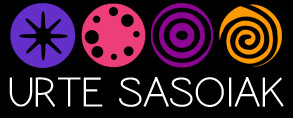VIDEO SCRIPT
Caro Baroja referred to the period starting in May and until the end of June, the time when the cuckoo calls, as the season for loving (“la estación de amor”). Winter coldness is over and the Sun’s heat becomes more intense, Nature awakes and animals and humans acquire new vigour and strength. This joyful season in which trees, flowers and greenery are glorified, lasts until the end of June.
Our ancestors’ veneration for the tree was an almost religious attitude of deep respect. Good proof of it is the Plantar el mayo custom still observed on 3 May in the small locality of Done Bikendi Harana. On this day two or three men head for the mountain to choose the straightest and longest beech tree, cut it down and transport it to the village. In the afternoon they raise it and make it stand upright, and there it will stay until 14 September, protecting the village from all evil. They call the tree mayo, hence the name of the ritual, literally to plant the mayo. In Lesaka a similar practice used to be followed but is lost now. In the evening of 30 April May trees were placed outside the girls’ houses: beautiful trees for charming maidens and elder tree for plainer girls.
Erreginetan is another traditional custom celebrated in May, a vestige of ancient springtime rituals. Although it has been forgotten in most places, it is to date remembered in Baztan. In spite of small variations from village to village, a group or more than one group of girls aged between 8 and 12 took the leading role on this event. One of them played the part of Maia or Erregina, the queen. In some places the queen would sit on a table while her assistants sang wassail verses to passers-by and asked for a donation. As surprising as it might sound nowadays, at the end of the 18th century, Carlos III and Carlos IV banned the Maiak practice.
There is a Christian festivity at the beginning of June of great religious significance: the Feast of Corpus Christi. In Lapurdi and Nafarroa Beherea, it is known as Besta Berri. It continues to be observed in a handful of localities. The feast is celebrated on two Sundays in June, and apart from a spectacular parade, it counts with an element that makes it singular: the dance performed inside the church. Amongst ancient Basque people, the habit of dancing in the interior of the temple was widely spread: however, the practice was prohibited in the 16th century. The custom was introduced in Euskal Herria in the 14th century, although the costumes nowadays worn by the participants in the parade date from the 19th century. In Southern Euskal Herria, the finest example of this antique custom remains in Oñati, doubtlessly. Nevertheless, in the olden times the festival was better established and must have been pretty colourful with the presence of giants and dragons.
Slowly but surely one of the two peak moments in the traditional calendar has reached: the summer solstice; Christmas is the other highest point. Our ancestors organized their festivals according to Nature’s cycles, taking special account of the two solstices -the winter solstice on 24 December and the summer solstice on 24 June-.
From the moment they realized the influence of the summer solstice upon the course of the year and its meaning, it was, by force, source of numerous rituals. The days between 21 and 24 June are the longest of the year (round about 15 hours of daylight). From then onwards days become gradually shorter until Christmas. The festival of the summer solstice commemorates the arrival of the sunniest season, the summertime. These days were dedicated to honour the solar deity. Later on the Catholic Church established the celebration of the birth of Christ at the time of the winter solstice and the feast of Saint John the Baptist during the traditional summer festival. That is how both points of view intermingled, and the Sun started to be called Juan or Joanes.
The respect paid to the Sun in Euskal Herria is still present in multiple events. Dolmens, tombs and the bodies of the deceased are facing east, where the Sun rises. Modest prayers were uttered at sunset such as: “Adios amandre, bihar artio” (Goodbye, Lady Mother, until tomorrow), “Ekia, igorri zadak ederrago bat” (Sun, send us a beautiful one) or “Bihar artio Joanes!” (See you tomorrow Joanes!).
The sunflower has been the representative figure of the Sun in our culture. A sunflower used to be placed in the porch of the house on Saint John’s Day. When nocturnal creatures -witches, demons, lamias- saw the image of the Sun, they did not dare enter the house. Likewise, it was believed to protect the house from thunderstorm and lightning.
Fire, water and plants are the chief elements in the celebration of summer solstice rituals.
The belief that on Saint John’s Day the Sun is seen dancing at sunrise above the horizon was widespread throughout the whole of the Basque territory. In Zeanuri, for instance, it was common to climb barefoot to Gorbeia to watch the Sun rise.
Nevertheless, fire is the major symbol of the festival. Bonfires are still lit nowadays in village squares, farmhouses, fields and crossroads. Old and young, girls and boys, would meet around the fire and even jump over it three times conjuring up magic formulas similar to this one gathered in Elgeta: “San Joan, San Joan berde, artuak eta garixak gorde, lapurrak eta sorgiñak erre. Biba San Joan berde!” (Saint John, green Saint John, look after the maize and the wheat, burn the thieves and the witches. Hurray for green Saint John!).
In Urdiain young girls holding hands around the fire sing a particular song in an evening of magical conjurations.
In olden times the remains of the flowers and branches from the previous year’s Saint John’s bunch were hurled on the fire. The power of fire is outstanding, and almost anything could be asked to it: to fend off skin disease, protection against witchcraft, to look after the crops, cure from illness…
We have mentioned fire, and let us now talk about water rituals. Water from seas, rivers and sources, and even the morning dew, possess a magical quality on this day. It was believed that stones became bread and water turned into wine on the eve of Saint John’s Day, at midnight sharp.
As the day broke, walking on grass wet with dew was a well known custom across the length and breadth of Euskal Herria. Men and women alike would take a walk on the morning dew of Saint John’s Day, doniane-ihintza hartzea, and sometimes sheep were made to join them.
In certain places of Nafarroa people walked across wheat fields naked to be impregnated by the morning dew that would stop them from catching skin infections.
Equally, water from sources and rivers had special virtues on the day. As soon as morning broke, hands, face and feet were cleaned in those waters. In Nafarroa the practice of bathing oneself in a river or source at midnight was known as sanjuanada.
The plants are the third element we shall consider. Plenty of local customs related to plants and trees have survived to date, such as the ritual of the bunch. On the eve of Saint John’s Day a bouquet was arranged by the housewife: Saint John’s bouquet.
The bouquet was made of grasses, flowers, maize leaves, heads of garlic, apple tree branches and fern. The following day, Saint John’s Day, the bouquet was taken to mass to be blessed and returned to the house to be saved hanging from the attic ceiling in order to be used as needed. When lightning stroke, some grasses from the bunch were thrown to the fire. If a household member became poorly, some of these leaves were boiled and the ill person would breathe in the steam. The remains of the bunch from the previous year were burned on the Saint John’s Eve bonfire.
In Laguardia summer festival the dancers take the leading role together with Cachimorro. While they dance, they hand Saint John’s bouquets over to the members of the council. The dance is performed in the morning and in the afternoon, and surprising as it might sound, the ritual, including the sharing out of the flower bouquets, is repeated on Saint Peter’s Day.
Early morning on Saint John’s Day, villagers would walk barefoot up the mountain to cut ash tree or hawthorn branches and brought them back home. The branches were placed on both sides of the entrance doors and remained there for the whole year until they were burned on Saint John’s bonfire. The custom is still observed and its practice is believed to protect the house and the household from thunderstorm.
However, the journey to the mountain to collect fern is a nearly forgotten ancient habit. Fern was brought and spread in the porch of the house. It was kept there for around forty days and later saved to be burned in the following year’s bonfire.
In Altsasu fern and ash tree branches are still seen at the entrance to houses on Saint John’s Day. But there is a detail to be added: it is the village boys who decorate girls’ balconies with ash tree or black poplar branches; like in Lesaka, nice-looking girls receive ash tree branches and plainer girls content themselves with black poplar.
The tradition of raising a large tree in a public spot on Saint John’s Eve and making it stand straight was a settled custom in the past. Ash tree or black poplar was mostly used. The tradition has been maintained in quite a number or places: Urrestilla, Agurain, Donostia… After the tree is blessed and lit, it is brought down to the floor and skin pieces are peeled off or branches cut off and saved at home for their magical qualities. Nowadays the ritual takes place on Saint John’s Day instead of on the eve.
We wish to explain another popular custom linked to trees. It is less known than the above-mentioned routines and was meant to cure hernias. On the eve of Saint John’s Day, at midnight, two men named Juan carried the ill child next to an oak tree. They would make a hole in the tree trunk with an axe, and the child was passed through the gap. One said “Juanek uzten zaitu” (Juan leaves you), and the other replied “Juanek hartzen zaitu” (Juan takes you). Then the opened hole was filled. If the tree survived, the child was healed, but not if it dried. This custom, or any of its variants, has been observed throughout our territory.
Two of the elements referred to -the tree and the bouquet of flowers- are part of Saint John’s festival in Agurain. On the eve a black poplar is placed in the middle of the square and left to stand there until 25 June. Early in the morning on Saint John’s Day the members of the council ride on horses to Arrizala. They attend mass and head back for Agurain. There the villagers wait for them and present them with beautiful Saint John’s bouquets.
To finish our journey, we shall make a last stop in Tolosa. On Saint John’s Day the streets are adorned with ash tree branches, as the occasion requires. The sound of San Juan zortzikoa is endlessly heard all day, but there is an extraordinary dance which is only performed on this day in remembrance of a 14th century battle: Bordon-dantza.
The journey started on May and followed until the summer solstice has come to an end. Summertime has already arrived, and from now on, as the sayings goes: “Orain arte belar, hemendik aurrera gari!” (Grass season until now, wheat from now on!).




